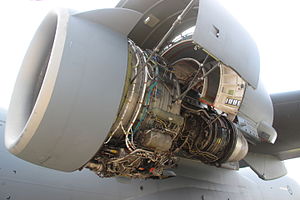| PW2000/F117 | |
|---|---|

| |
| F117 engine with cowlings opened | |
| Type | Turbofan |
| National origin | United States |
| Manufacturer | Pratt & Whitney |
| First run | December 1981 |
| Major applications | Boeing 757 Boeing C-17 Globemaster III Boeing C-32A Ilyushin Il-96M |
The Pratt & Whitney PW2000, also known by the military designation F117 and initially referred to as the JT10D, is a series of high-bypass turbofan aircraft engines with a thrust range from 37,000 to 43,000 lbf (160 to 190 kN). Built by Pratt & Whitney, they were designed for the Boeing 757. As a 757 powerplant, these engines compete with the Rolls-Royce RB211.
Design and development
Pratt & Whitney began working on the JT10D in October 1971 intended for the McDonnell Douglas YC-15 into the Advanced Medium STOL Transport project and the Boeing 767, then code named 7X7, which first ran in August 1974. In December 1980, Pratt & Whitney changed to a new naming system for its engines and the JT10D became the PW2037.
The PW2000 is a dual-spool, axial air flow, annular combustion, high bypass turbofan with a dual-channel full authority digital engine control (FADEC) system. It was certified in 1984 as the first civilian FADEC-controlled aviation engine.
MTU Aero Engines holds a 21.2% stake in the engine project, having developed the low-pressure turbine and turbine exit casing as well as producing critical parts of the low-pressure turbine, the turbine exhaust casing, high-pressure compressor and high-pressure turbine components.

The first PW2000 series engine, the PW2037, powered the Boeing 757-200 and entered service with Delta Air Lines as the launch customer for the civil aviation version of the engine.
Other than the 757, the PW2000 series engines also power the C-17 Globemaster III military transport; the United States Department of Defense designation for the engine is F117, with the specific variant used on the C-17 being the F117-PW-100. The powerplant first flew on the C-17 in 1991. Still maintaining the F117 engine for the U.S. military, Pratt & Whitney received a $5.5 billion contract modification in June 2023 for engine sustainment in San Francisco, California; Columbus, Georgia; and Tinker Air Force Base, Oklahoma, through September 2027.
The PW2000 also powered the abortive Ilyushin Il-96M; the engine first flew on the Il-96M in 1993.
On October 16, 2008 the NTSB recommended that the FAA issue urgent new inspection procedures on the PW2037 model of the engine, following an uncontained turbine failure event in August 2008. The NTSB recommended that the FAA order PW2037 engines inspected beyond a threshold of flight hours or flight cycles less than that of the event engine, and be reinspected at regular intervals.
The latest build standard, named PW2043, launched in 1994. It provides over 43,000 lbf (190 kN) of thrust. Previous generations of engines can be converted to the PW2043 version.
Applications
Specifications (PW2000)

Data from FAA
General characteristics
- Type: Turbofan
- Length: 146.8 in (3,729 mm)
- Diameter: 78.5 in (1,994 mm)
- Dry weight: 7,100 lb (3,221 kg)
Components
- Compressor: Axial, 1 stage fan with 36 blades, 4 stage LP, 12 stage HP
- Combustors: Annular
- Turbine: 2 stage HP, 5 stage LP
- Fuel type: Jet-A, Aviation kerosene
Performance
- Maximum thrust: 38,400–43,734 lbf (170.81–194.54 kN)
- Overall pressure ratio: 27.6-31.2:1
- Bypass ratio: 6.0:1
- Thrust-to-weight ratio: 5.41-6.16
See also
Comparable engines
Related lists
References
- ^ "2037: Pratt & Whitney tests new turbofan". Flight International. 19 December 1981.
- "PW2000 Engine: Lowest Operating Cost for Mid-Range-Thrust Engines" (PDF). Pratt & Whitney. October 2012. Archived from the original (PDF; 28 KB) on 24 September 2015. Retrieved 10 July 2013.
- "PW2000 Engine". Pratt & Whitney. Archived from the original on 14 February 2016. Retrieved 10 July 2013.
- Majumdar, Dave (March 7, 2012). "USAF seeks to bypass aircraft engine manufacturers". FlightGlobal. Retrieved 2012-09-05.
- National Research Council (2007). Improving the Efficiency of Engines for Large Nonfighter Aircraft. Washington, D.C.: National Academies Press. p. 38. ISBN 978-0-309-17913-3.
- "Factshets: C-17 Globemaster III". United States Air Force. Archived from the original on 2012-07-20. Retrieved 2012-09-05.
- "Contracts for June 30, 2023". U.S. Department of Defense. Retrieved 2023-07-22.
- NTSB Safety Recommendation A-08-85 Urgent and -86, National Transportation Safety Board, Oct 16, 2008
- "TCDS NUMBER E17N" (PDF). US FAA. (link: ). Retrieved 10 November 2017.
External links
| United States military gas turbine aircraft engine designation system | |
|---|---|
| Turbojets | |
| Turboprops/ Turboshafts | |
| Turbofans | |
| Adaptive cycle engines | |